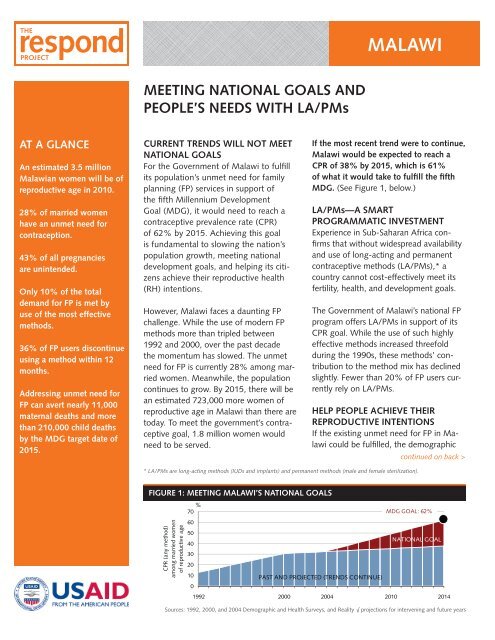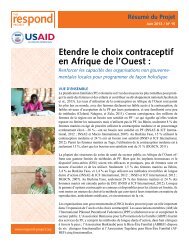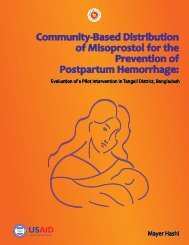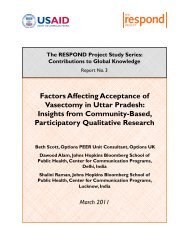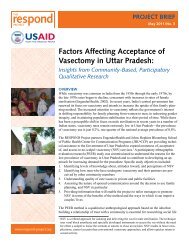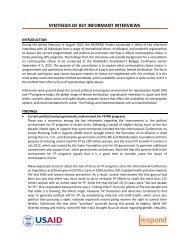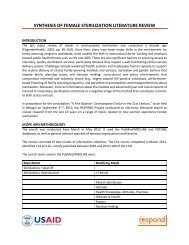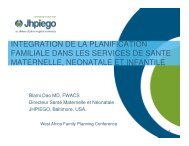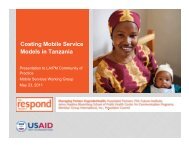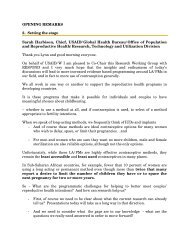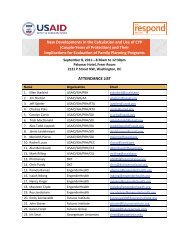MALAWI - the RESPOND Project!
MALAWI - the RESPOND Project!
MALAWI - the RESPOND Project!
You also want an ePaper? Increase the reach of your titles
YUMPU automatically turns print PDFs into web optimized ePapers that Google loves.
<strong>MALAWI</strong><br />
MEETING NATIONAL GOALS AND<br />
PEOPLE’S NEEDS WITH LA/PMs<br />
AT A GLANCE<br />
An estimated 3.5 million<br />
Malawian women will be of<br />
reproductive age in 2010.<br />
28% of married women<br />
have an unmet need for<br />
contraception.<br />
43% of all pregnancies<br />
are unintended.<br />
Only 10% of <strong>the</strong> total<br />
demand for FP is met by<br />
use of <strong>the</strong> most effective<br />
methods.<br />
36% of FP users discontinue<br />
using a method within 12<br />
months.<br />
Addressing unmet need for<br />
FP can avert nearly 11,000<br />
maternal deaths and more<br />
than 210,000 child deaths<br />
by <strong>the</strong> MDG target date of<br />
2015.<br />
CURRENT TRENDS WILL NOT MEET<br />
NATIONAL GOALS<br />
For <strong>the</strong> Government of Malawi to fulfill<br />
its population’s unmet need for family<br />
planning (FP) services in support of<br />
<strong>the</strong> fifth Millennium Development<br />
Goal (MDG), it would need to reach a<br />
contraceptive prevalence rate (CPR)<br />
of 62% by 2015. Achieving this goal<br />
is fundamental to slowing <strong>the</strong> nation’s<br />
population growth, meeting national<br />
development goals, and helping its citizens<br />
achieve <strong>the</strong>ir reproductive health<br />
(RH) intentions.<br />
However, Malawi faces a daunting FP<br />
challenge. While <strong>the</strong> use of modern FP<br />
methods more than tripled between<br />
1992 and 2000, over <strong>the</strong> past decade<br />
<strong>the</strong> momentum has slowed. The unmet<br />
need for FP is currently 28% among married<br />
women. Meanwhile, <strong>the</strong> population<br />
continues to grow. By 2015, <strong>the</strong>re will be<br />
an estimated 723,000 more women of<br />
reproductive age in Malawi than <strong>the</strong>re are<br />
today. To meet <strong>the</strong> government’s contraceptive<br />
goal, 1.8 million women would<br />
need to be served.<br />
If <strong>the</strong> most recent trend were to continue,<br />
Malawi would be expected to reach a<br />
CPR of 38% by 2015, which is 61%<br />
of what it would take to fulfill <strong>the</strong> fifth<br />
MDG. (See Figure 1, below.)<br />
LA/PMs—A SMART<br />
PROGRAMMATIC INVESTMENT<br />
Experience in Sub-Saharan Africa confirms<br />
that without widespread availability<br />
and use of long-acting and permanent<br />
contraceptive methods (LA/PMs),* a<br />
country cannot cost-effectively meet its<br />
fertility, health, and development goals.<br />
The Government of Malawi’s national FP<br />
program offers LA/PMs in support of its<br />
CPR goal. While <strong>the</strong> use of such highly<br />
effective methods increased threefold<br />
during <strong>the</strong> 1990s, <strong>the</strong>se methods’ contribution<br />
to <strong>the</strong> method mix has declined<br />
slightly. Fewer than 20% of FP users currently<br />
rely on LA/PMs.<br />
HELP PEOPLE ACHIEVE THEIR<br />
REPRODUCTIVE INTENTIONS<br />
If <strong>the</strong> existing unmet need for FP in Malawi<br />
could be fulfilled, <strong>the</strong> demographic<br />
continued on back ><br />
* LA/PMs are long-acting methods (IUDs and implants) and permanent methods (male and female sterilization).<br />
FIGURE 1: MEETING <strong>MALAWI</strong>’S NATIONAL GOALS<br />
CPR (any method)<br />
among married women<br />
of reproductive age<br />
%<br />
70<br />
60<br />
50<br />
40<br />
30<br />
20<br />
MDG GOAL: 62%<br />
NATIONAL GOAL<br />
10<br />
PAST AND PROJECTED (TRENDS CONTINUE)<br />
0<br />
1992 2000 2004 2010 2014<br />
Sources: 1992, 2000, and 2004 Demographic and Health Surveys, and Reality √ projections for intervening and future years
<strong>MALAWI</strong><br />
For inquiries,<br />
please contact:<br />
Lynn Bakamjian<br />
<strong>Project</strong> Director, <strong>RESPOND</strong><br />
EngenderHealth<br />
212-561-8000<br />
lbakamjian@engenderhealth.org<br />
Carolyn Curtis<br />
AOTR, <strong>RESPOND</strong><br />
USAID/W/GH/PRH/SDI<br />
202-712-4982<br />
ccurtis@usaid.gov<br />
© 2009<br />
The <strong>RESPOND</strong> <strong>Project</strong><br />
at EngenderHealth<br />
440 Ninth Avenue<br />
New York, NY 10001<br />
212-561-8000<br />
info@respond-project.org<br />
www.respond-project.org<br />
Managing Partner:<br />
EngenderHealth;<br />
Associated Partners:<br />
Cicatelli Associates Inc.<br />
Family Health International<br />
Futures Institute<br />
Johns Hopkins University<br />
Bloomberg School of<br />
Public Health Center for<br />
Communication Programs<br />
Meridian Group<br />
International, Inc.<br />
Population Council<br />
June 15, 2009<br />
impact would be substantial. LA/PMs<br />
have an important role to play and offer<br />
multiple benefits to programs, women,<br />
and couples.<br />
LA/PMs are vital to address <strong>the</strong> dissonance<br />
between women’s expressed<br />
reproductive intentions and <strong>the</strong>ir method<br />
use. The gap between intention and practice<br />
could be closed by increasing awareness<br />
of LA/PMs, correcting misinformation<br />
about <strong>the</strong>m, and increasing <strong>the</strong>ir<br />
availability to expand method choice.<br />
Though IUDs and implants are <strong>the</strong> most<br />
effective methods for women who want<br />
to space <strong>the</strong>ir births, <strong>the</strong>se long-acting<br />
methods constitute a very small share<br />
of <strong>the</strong> method mix for both spacers and<br />
limiters in Malawi. (See Figure 2, below.)<br />
Unlike many of its African counterparts,<br />
Malawi shows a significant level of sterilization<br />
use. Almost one-quarter of <strong>the</strong><br />
total demand for limiting is met by sterilization.<br />
This indicates potential for more<br />
robust programming focused on LA/PMs.<br />
Greater access to correct information and<br />
services, particularly for long-acting methods,<br />
would enable people to meet <strong>the</strong>ir<br />
changing needs as <strong>the</strong>y progress through<br />
<strong>the</strong>ir reproductive lives.<br />
<strong>RESPOND</strong> to <strong>MALAWI</strong>’s Needs<br />
The <strong>RESPOND</strong> <strong>Project</strong> can help <strong>the</strong><br />
Ministry of Health and <strong>the</strong> USAID Mission’s<br />
implementing partners to achieve<br />
<strong>the</strong>ir FP and reproductive health (RH)<br />
goals by taking a holistic programmatic<br />
approach that addresses <strong>the</strong> essential<br />
components of supply, demand, and<br />
advocacy. Possible interventions<br />
include:<br />
Reality √, a cutting-edge forecasting<br />
and planning tool that generates data<br />
for realistic, evidence-based service,<br />
training, and commodity projections<br />
State-of-<strong>the</strong>-art technical assistance to<br />
streng<strong>the</strong>n service delivery support systems<br />
(training, supervision, and contraceptive<br />
security) and communications<br />
campaigns to address LA/PMs<br />
Strategies to revitalize specific methods,<br />
such as sterilization, <strong>the</strong> IUD,<br />
and implants, including <strong>the</strong> introduction<br />
of Sino-implant (II) (<strong>the</strong> lowercost<br />
generic version of <strong>the</strong> contraceptive<br />
implant Jadelle), for which<br />
registration is currently under review<br />
in Malawi<br />
Proven programmatic models to improve<br />
and scale up access to FP/RH<br />
services by integrating LA/PMs into<br />
o<strong>the</strong>r services (community postabortion<br />
care, FP/HIV/maternal and child<br />
health services, private practitioner<br />
networks, and mobile outreach for <strong>the</strong><br />
underserved urban and rural poor)<br />
FIGURE 2: <strong>MALAWI</strong>’S DEMAND FOR CONTRACEPTION (MET AND UNMET NEED)<br />
Demand to space<br />
Demand to limit<br />
% of reproductiveage<br />
women who are<br />
married or in a union<br />
0.3<br />
6.0<br />
13.1<br />
0.3<br />
9.0<br />
1.7<br />
1.0<br />
0% 5% 10% 15% 20% 25% 25% 30% 35% 30%<br />
Permanent Long-acting Short-acting Traditional Unmet need<br />
10.4<br />
17.2<br />
Source: 2004 Demographic and Health Survey


